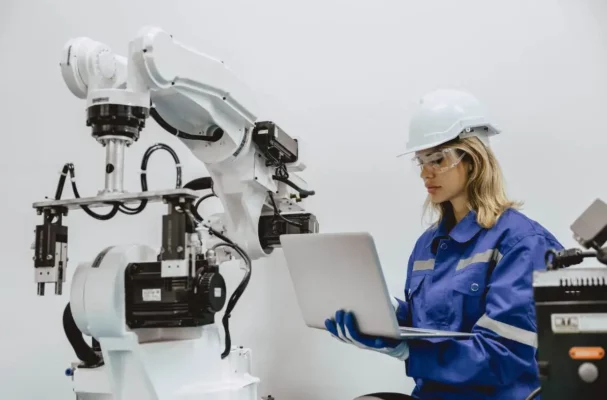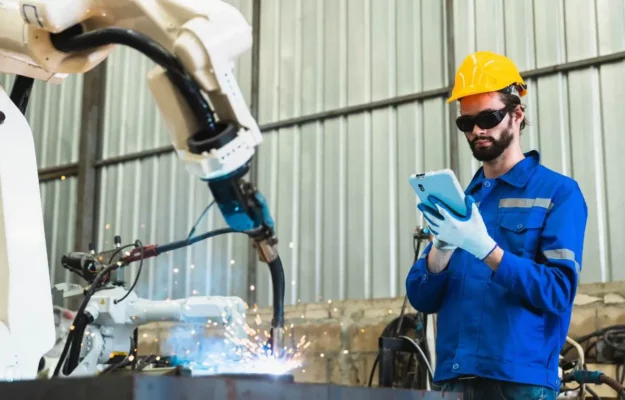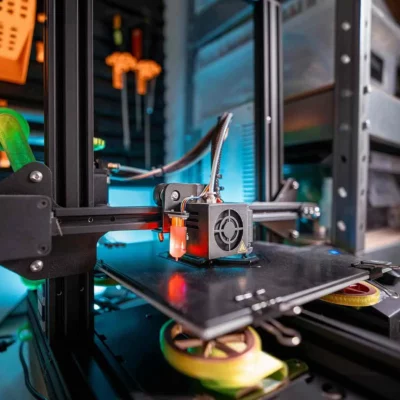Deciding how to pay for your robot software is important for your manufacturing line’s success and budget. Should you choose a subscription that offers flexibility and regular updates? Or go for a one-time fee, giving you full ownership without ongoing costs? Each choice has its benefits and challenges, depending on what you need and how much you’re willing to spend. This guide will help you understand both options, so you can pick the one that best suits your goals and financial plans.
Let’s get started and find the right choice for you.
What is Robot Software?
Robot software is what makes your robot work. It controls everything your robot does, from simple movements to complex tasks. Without software, your robot wouldn’t know what to do.
How Does Robot Software Work?
Robot software turns your commands into actions. It reads input from sensors, processes the information, and then guides your robot’s movements. You can choose from different software types depending on what you need your robot to do.
Software Options:
- Offline Programming: Write and test programs without stopping your production line.
- Simulation: See how your robot will perform tasks in a virtual environment before doing it for real.
- Monitoring: Keep an eye on your robot’s performance and fix issues right away.
- Bin Picking: Sort and pick items from bins efficiently.
- Palletizing: Stack and organize items automatically.
- Calibration: Make sure your robot stays accurate over time.
- Developer Tools: Customize your robot’s behavior to fit your needs.
- Vision: Use cameras and sensors to improve your robot’s precision.
- Scheduling: Plan and manage your robot’s tasks easily.
- Welding: Get precise control over welding tasks with specialized software.
Understanding the Payment Models:
Choosing between a subscription and a one-time fee for your robot software is a key decision. Both have their own benefits, depending on what you need and how you want to manage your budget.
Subscription Model:
With a subscription, you make regular payments, usually monthly or yearly. For example, you might pay between $50 and $300 per month for robot software, depending on the features you need. This model ensures you always have the latest updates and access to support. It’s a flexible option, especially if your needs might change over time. Software as a Service (SaaS) is becoming more popular in industrial automation, making it easier for you to adapt and scale your operations.
One-Time Fee Model:
A one-time fee means you pay upfront, with costs ranging from $5,000 to $20,000 depending on the software. This gives you full ownership, so you won’t have to worry about ongoing payments. It’s a good choice if you prefer to pay once and use the software as long as you need. Some robot software still offers this model, which can be ideal if you want to avoid subscription renewals and future price increases.
By understanding these payment models, you can choose the one that best fits your needs and budget.
Need a quick way to figure out the best way to pay for your robot software? Let Qviro’s AI Automation Assistant, Alina, help you. In just one minute, Alina can give you a cost estimate tailored to your business. Alina makes it easy to find the right financial option for you. Why wait?
GET YOUR FREE ESTIMATE WITH ALINA NOW!
Pros & Cons of Subscription Models:
Flexibility & Scalability:
Subscriptions give you the flexibility to adjust your software as your business grows. If you need more features or capacity, you can easily scale up without a large upfront cost. Recent studies show that the preference for on-premise software subscriptions has increased from 63% to 82%. This trend shows that more businesses like yours are choosing subscriptions to stay adaptable without committing to significant initial expenses.
Cost Considerations:
With a subscription, you start with lower costs. For example, you might pay $50 to $300 per month instead of a large one-time fee. But over time, these costs can add up. Depending on how long you use the software, the total expense could be higher than buying it outright. Some industries, like manufacturing, have switched to subscriptions because it helps manage cash flow, even if it means paying more in the long run.
Regular Updates & Support:
Subscriptions keep your software up-to-date. You get the latest features and security updates regularly, which helps you avoid outdated software that no longer meets your needs. With a subscription, your software stays relevant and functional, so you can keep your business running smoothly without worrying about outdated tools.

Pros & Cons of One-Time Fee Models:
Cost-Efficiency Over Time:
Paying once for your software can be more cost-effective, especially if your needs are stable and long-term. With a one-time fee, which typically ranges from $5,000 to $20,000, you avoid the ongoing costs that come with subscriptions. This approach can save you money in the long run, particularly if you run a small business with a limited budget. Unlike subscriptions, where costs accumulate over time, a one-time fee gives you a clear, upfront expense, making it easier to manage your finances.
Ownership & Control:
When you pay a one-time fee, you fully own the software. This means you can use it as long as you need without worrying about recurring payments. However, the downside is that your software might become outdated since you won’t automatically receive updates. Without regular updates, your software might lack the latest features or security patches, which could affect your operations.
Upfront Investment:
The main challenge with a one-time fee is the higher initial cost. This can impact your cash flow, especially if your budget is tight. However, if you have enough capital, this model might work better for you. It removes the need for ongoing payments and could be more cost-effective in the long run, provided you can handle the upfront expense.

Industry Trends:
The trend toward subscription models in the robotics and industrial sectors is growing fast. More than 80% of businesses now choose subscription-based software, up from 63% a few years ago. Companies like Adobe and Autodesk have moved to this model, offering their software for $50 to $300 per month. This shift gives you regular updates and the flexibility to adjust your software as your needs change. With subscriptions, you avoid large upfront costs, making it easier for you to manage your budget and keep your tools up-to-date.
3 Factors to Consider When Choosing:
1. Your Company’s Size & Budget:
If you run a smaller company, your budget plays a big role in choosing a payment model. A subscription might suit you better with lower upfront costs, typically between $50 and $300 per month. This approach spreads out your expenses, making it easier to manage cash flow. However, if you can afford a one-time payment, usually between $5,000 and $20,000, you could save more in the long run by avoiding ongoing fees.
2. Your Industry’s Pace of Innovation:
If you work in a fast-changing industry like tech or manufacturing, a subscription model might be the best fit. It keeps your software updated with the latest features and security patches. This ensures you’re always using current tools, helping you stay competitive without needing to buy new software frequently.
3. Long-Term vs. Short-Term Needs:
For companies with stable, long-term operations, a one-time fee might be a smarter choice. You pay once and own the software indefinitely, which is ideal if your needs aren’t likely to change. But if you expect rapid growth or changes, a subscription could be more practical. It allows you to adjust your software as your business evolves, giving you the flexibility to adapt quickly.

Making the Final Decision:
Comparison Table:
| Factor | Subscription | One-Time Fee |
|---|---|---|
| Cost | $50-$300 per month | $5,000-$20,000 upfront |
| Updates | Regular updates included | Updates not included |
| Support | Continuous support with subscription | Initial support only |
| Scalability | Easily scalable as your needs change | Limited scalability, requires new purchase for upgrades |
Expert Recommendations:
When deciding between a subscription or a one-time fee, think about your industry and what your business needs. If you’re in a fast-moving industry, like tech or manufacturing, a subscription might suit you better. It keeps your software up-to-date and lets you adjust as your needs change. But if your industry is stable and your software needs won’t change much, a one-time fee could save you money over time. You pay once, own the software, and avoid ongoing costs. This option works well if you have the budget for the upfront payment.
Conclusion:
Choosing the right payment model for your robot software is important for your business. Subscriptions offer flexibility and regular updates, making them a good choice if your industry changes quickly. If your needs are stable and you prefer to avoid ongoing costs, a one-time fee could save you money in the long run. Think about your industry, budget, and future needs when making this decision.






